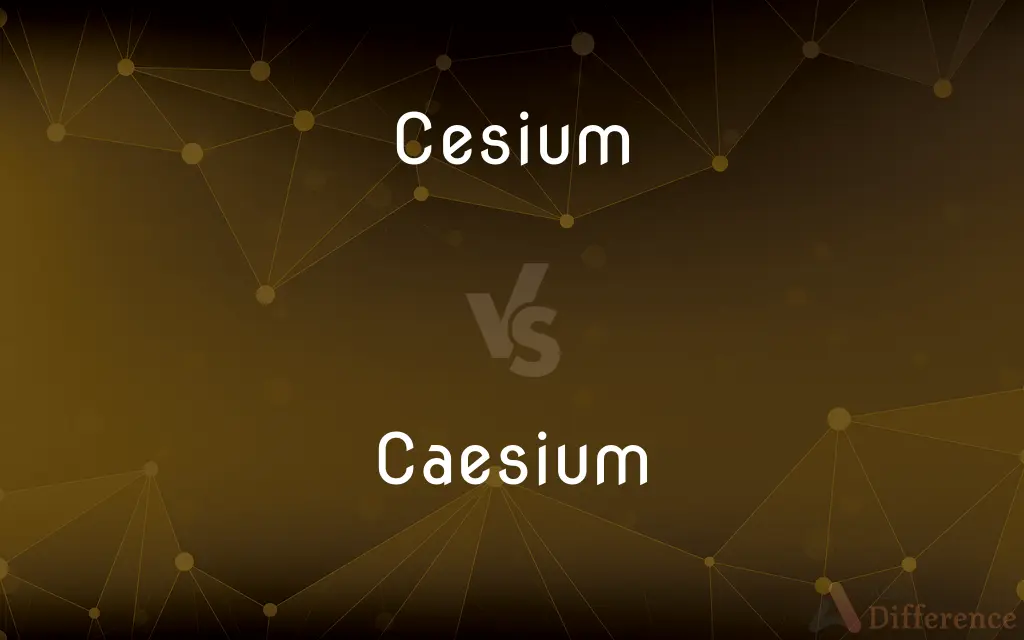Cesium vs. Caesium — What's the Difference?
By Urooj Arif & Maham Liaqat — Updated on May 1, 2024
Cesium and caesium are two spellings for the same chemical element; "cesium" is preferred in American English, while "caesium" is used in British English.

Difference Between Cesium and Caesium
Table of Contents
ADVERTISEMENT
Key Differences
Cesium is the spelling commonly used in the United States and in the field of chemistry when referring to the element with atomic number 55. On the other hand, caesium is the spelling preferred in the United Kingdom and other countries following British English conventions.
In scientific articles and textbooks published in the U.S., the term "cesium" is overwhelmingly prevalent. Whereas in British publications, "caesium" aligns with other elements like aluminium.
The International Union of Pure and Applied Chemistry (IUPAC) officially recognizes "caesium" as the standard spelling, while it acknowledges "cesium" as an acceptable variant. Conversely, American scientific bodies and educational institutions typically use "cesium".
The pronunciation of the element can also vary slightly depending on the spelling; "cesium" is typically pronounced as "SEE-zee-um" in American English. Whereas "caesium" is often pronounced as "SEE-zee-um" or "SEE-see-um" in British English contexts.
Despite the differences in spelling, both terms refer to the same soft, silvery-gold alkali metal known for its low melting point and reactive properties.
ADVERTISEMENT
Comparison Chart
Spelling
Cesium
Caesium
Usage
Predominantly in the US
Mainly in the UK
IUPAC Recognition
Accepted variant
Official standard
Pronunciation
SEE-zee-um
SEE-zee-um / SEE-see-um
Publication Preference
American publications
British publications
Compare with Definitions
Cesium
A metallic element with atomic number 55, known for its high reactivity.
Cesium reacts explosively with water.
Caesium
A chemical element with symbol Cs and atomic number 55.
Caesium is located in group 1 of the periodic table.
Cesium
Plays a crucial role in atomic clocks.
Cesium atomic clocks are extremely accurate.
Caesium
Noted for its use in atomic clocks.
Caesium clocks measure time with exceptional precision.
Cesium
Utilized in medical applications.
Cesium isotopes are used in cancer therapy.
Caesium
A conductor of electricity.
Caesium compounds can conduct electricity when molten.
Cesium
Can be found in mineral form.
Cesium is sometimes extracted from pollucite.
Caesium
Extracted primarily from mineral sources.
Caesium is typically mined from lepidolite.
Cesium
Used in various industries for its conductive properties.
Cesium is often used in photoelectric cells.
Caesium
Used in medical treatments.
Caesium salts are utilized in radiotherapy.
Cesium
A soft, silvery-white ductile, metallic element that is the most electropositive and alkaline of the elements and is used in atomic clocks and photoelectric cells and to catalyze hydrogenation of some organic compounds. The fundamental unit of time in the International System, the second, is based on the frequency of radiation between two energy states in an atom of the Cs-133 isotope. Atomic number 55; atomic weight 132.905; melting point 28.44°C; boiling point 671°C; specific gravity 1.873; valence 1. See Periodic Table.
Caesium
Caesium (IUPAC spelling) (also spelled cesium in American English) is a chemical element with the symbol Cs and atomic number 55. It is a soft, silvery-golden alkali metal with a melting point of 28.5 °C (83.3 °F), which makes it one of only five elemental metals that are liquid at or near room temperature.
Cesium
(American spelling) caesium
Caesium
Variant of cesium.
Cesium
The chemical element of atomic number 55. It is a univalent element, the most electropositive metal. Symbol Cs; atomic weight 132.905. IT has a melting point of 28.4° C.
Caesium
The chemical element (symbol Cs) with an atomic number of 55. It is a soft, gold-colored, highly reactive alkali metal.
Cesium
A soft silver-white ductile metallic element (liquid at normal temperatures); the most electropositive and alkaline metal
Caesium
A rare alkaline metal found in mineral water; - so called from the two characteristic blue lines in its spectrum. It was the first element discovered by spectrum analysis, and is the most strongly basic and electro-positive substance known. Symbol Cs. Atomic number 55. Atomic weight 132.6.
Caesium
A soft silver-white ductile metallic element (liquid at normal temperatures); the most electropositive and alkaline metal
Common Curiosities
What are the physical properties of cesium/caesium?
Cesium/caesium is soft, silvery-gold, and has a low melting point.
How is cesium/caesium obtained?
Cesium and caesium are typically extracted from the mineral pollucite.
Is cesium radioactive?
Natural cesium is not radioactive, but cesium-137, a byproduct of nuclear reactions, is radioactive.
Why is cesium/caesium so reactive?
Due to its large atomic size and low ionization energy, cesium/caesium is highly reactive.
What are the safety concerns associated with cesium/caesium?
Cesium/caesium is highly reactive with water and air, requiring careful handling and storage.
What role does cesium/caesium play in atomic clocks?
Cesium/caesium’s precise electron transitions are used to measure time in atomic clocks.
How is cesium/caesium stored to prevent reactivity?
Cesium/caesium is stored in vacuum-sealed glass ampoules or under inert gas to prevent reactivity.
Can cesium/caesium be found in nature?
Yes, cesium/caesium occurs naturally in minerals like pollucite and lepidolite.
Are there any biological roles for cesium/caesium?
Cesium/caesium has no known biological role and is not considered essential for life.
What are common uses of cesium/caesium?
Cesium and caesium are used in atomic clocks, oil drilling, and medical applications.
What is the electron configuration of cesium/caesium?
The electron configuration of cesium/caesium is [Xe] 6s¹.
What compounds can cesium/caesium form?
Cesium/caesium forms various compounds, including cesium chloride and cesium nitrate.
How does cesium/caesium react with water?
Cesium/caesium reacts violently with water, producing hydrogen gas and heat.
What is the atomic weight of cesium/caesium?
The atomic weight of cesium/caesium is approximately 132.9 u.
What is the impact of radioactive cesium on the environment?
Radioactive cesium can contaminate water and soil, posing long-term environmental and health risks.
Share Your Discovery

Previous Comparison
Contortion vs. Distortion
Next Comparison
Parry vs. BlockAuthor Spotlight
Written by
Urooj ArifUrooj is a skilled content writer at Ask Difference, known for her exceptional ability to simplify complex topics into engaging and informative content. With a passion for research and a flair for clear, concise writing, she consistently delivers articles that resonate with our diverse audience.
Co-written by
Maham Liaqat















































